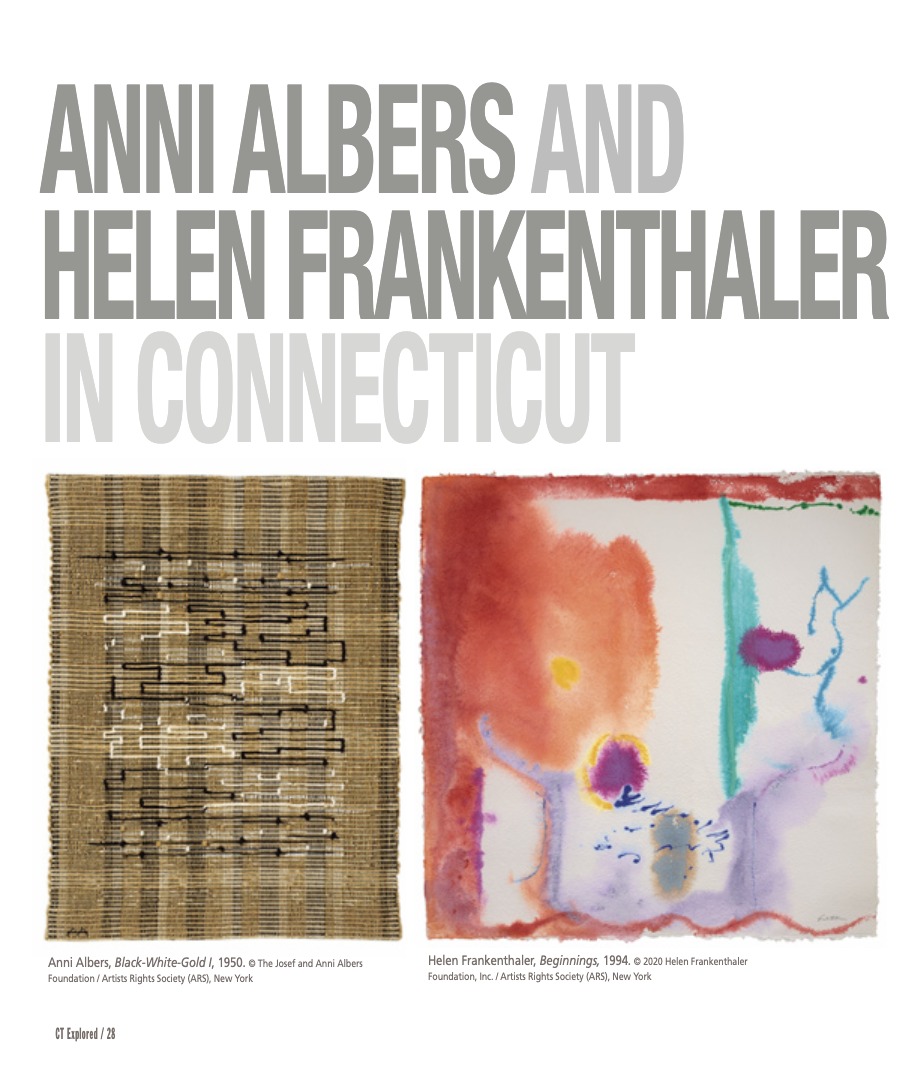(c) Connecticut Explored Inc. Summer 2020
Subscribe/Buy the Issue!
The New Britain Museum of American Art (NBMAA) is one of the oldest museums dedicated exclusively to American art. In 2020, in recognition of the 100th anniversary of American women’s gaining the right to vote, the NBMAA presents 2020/20+ Women @ NBMAA, a year-long series of seven groundbreaking exhibitions dedicated exclusively to women artists. One hundred years after women gained the right to vote, only 27 percent of major exhibitions worldwide are devoted to women artists, according to the National Museum of Women in the Arts. Challenging underrepresentation and celebrating diversity, 2020/20+ Women @ NBMAA features acclaimed artists including Kara Walker, Anni Albers, Shantell Martin, Yoko Ono, Nancy Spero, Jaune Quick-to-See Smith, Carrie Mae Weems, Jennifer Wen Ma, Helen Frankenthaler, and others. Among the many artists celebrated are two with close ties to Connecticut: Anni Albers (1899 – 1994) and Helen Frankenthaler (1928 – 2011), both of whom spent decades living and working in the state and whose work reflects the impact of their time here.
In Thread and On Paper: Anni Albers in Connecticut, on view through June 14, was co-organized by the Josef and Anni Albers Foundation and curated by the foundation’s education director Fritz Horstman. This is the first museum exhibition to explore Albers’s diverse output during her 44 years in Connecticut and is the artist’s first major solo exhibition at a U.S. museum in 20 years. Focusing on the innovative work and writing Albers produced in Connecticut from the 1950s through the end of her life, In Thread and On Paper includes an extensive body of textiles, wall hangings, commercial collaborations, and works on paper, along with the artist’s loom, historic ephemera, and an interactive weaving wall that brings her art to life. [For more about Albers, see “Josef & Anni Albers in Connecticut,” Winter 2018 – 2019.]
Albers is considered by many—including Tate Modern in London which mounted an exhibition of her work in 2018—to be among the most important textile artists of the 20th century, and was an influential designer, printmaker, and educator. In Thread and On Paper explores the innovative work that she created after moving to New Haven in 1950, building from and expanding upon her experiences at the Bauhaus in Germany and Black Mountain College in North Carolina. The exhibition reflects upon Albers’s integration of traditional weaving techniques with cutting-edge materials and technologies to create mass-producible fabric patterns, “pictorial” weavings, and prints. She experimented in these media in unprecedented ways while developing further as a highly original abstract artist. In the exhibition, Albers’s textiles and works on paper are considered in the context of her important theoretical publications of the 1960s, On Designing and On Weaving, which helped establish these subjects as serious areas of academic study, as art historian Briony Fer noted in Tate, Etc. (Autumn 2018).
Over Time, We’re Left with the Best: Helen Frankenthaler Late Works, 1990-2003 will be the first museum presentation dedicated to the exploration of works from Helen Frankenthaler’s late life. Opening November 13, the exhibition will feature approximately 22 large-scale works on paper dating from 1990 to 2003, many of which were executed during Frankenthaler’s residence in Stamford. The exhibition is curated by Douglas Dreishpoon, director of the Helen Frankenthaler Catalogue Raisonne and chief curator emeritus of the Albright-Knox Art Gallery, with loans from the collection of the Helen Frankenthaler Foundation.
Frankenthaler, whose career spanned six decades, has long been recognized as one of the great American artists of the 20th century. Eminent among the second generation of post-World War II American abstract painters, she is widely credited for pioneering the transition from Abstract Expressionism to Color Field painting. Through her invention of the soak-stain technique, she expanded the possibilities of abstract painting while referencing figuration and landscape in unique ways.
In the later stages of Frankenthaler’s life—after she moved to her home and studio in Connecticut near the water—her practice continued to evolve. She experimented with charcoal, crayon, pastel, pen and ink, and acrylic paint that she thinned out and applied with brushes, sponges, and an array of hardware tools. She shifted from painting canvas on the floor to using larger sheets of paper that were either laid out on the floor or on table tops for easy access. As Dreishpoon notes, “While continuing to address themes and motifs that appear in her earlier output, Frankenthaler’s late work reveals how she accommodated age through an engaged and ever-active imagination.”
Anni Albers and Helen Frankenthaler are recognized for their tremendous contributions to the artistic heritage of our state and are both members of the Connecticut Women’s Hall of Fame. Here at the NBMAA, we continue to honor these iconic artists, whose innovative work has influenced visual culture beyond measure.
Lisa Hayes Williams is associate curator at the New Britain Museum of American Art.
Explore!
New Britain Museum of American Art
56 Lexington Street, New Britain
nbmaa.org
Read more stories about Connecticut’s art history on our TOPICS page.

